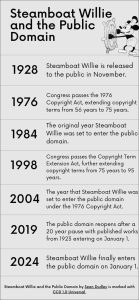Congratulations! We now all own an historic Mickey Mouse cartoon.
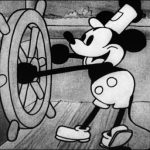
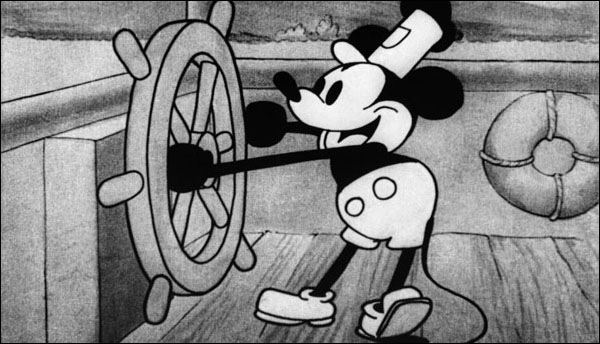
In 1978 Disney publicly celebrated Mickey Mouse’s 50th birthday with much fanfare, but they also had a less show reason to celebrate. As Mickey turned half a century old, the 1976 Copyright Act went into effect. This Act was the first major revision to the American copyright system in nearly 70 years and the first to be passed since Mickey Mouse’s debut in Steamboat Willie in 1928. Part of the Act’s provisions extended the length of copyright term for works already under copyright at that point in time, from 56 years to 75 years. This included Steamboat Willie and all subsequent Mickey Mouse cartoons.
Then in 1998 Disney once again held a celebration as the Copyright Term Extension Act was passed, further extending copyright terms for all by another 20 years, including for the 70 year old Mickey. And while this time they hoped for a more private celebration it did not come as the act was commonly called The Mickey Mouse Protection Act by its critics. This meant that no published works would enter the American public domain until 2019, and Mickey Mouse was further protected until 2024.
For those who aren’t copyright nerds like me, copyright is the exclusive, time-limited right to reproduce, distribute, adapt, or otherwise use intellectual property for a fixed period of time. Following the 1998 act, copyright lasts for 95 years from publication for works for corporate works, like Mickey Mouse and Steamboat Willie. For works where individual authors hold the rights, protections persist for the life of the author and 70 years after their death. Since copyright expires at the end of a calendar year, published works from 1928 will enter the American public domain on January 1, 2024.
And while 2024 might not be a cause for celebration in Disney’s eyes, it is one for the rest of us. From 1978-2024 only eight years worth of published works have entered the American public domain. During that time, Mickey was set to enter twice in 1985 and 2004 before any term extensions. During this extra 40 years of term extension, Disney has been able to effectively write and control their own version of the history of animation in nearly every regard. They were able to launch Mickey into icon status with no creative input or iterations from the public for 95 years, cementing him, and Disney itself, as the center and authority of modern animation. However, as the public domain has reopened over the last few years there are more opportunities for this narrative Disney has written to change.
Many contemporary works of the 1920s now have a chance for recirculation, reevaluation, and escape from the shadow of Steamboat Willie as they are no longer beholden to rights holders who were restrictive over them, or in some cases were impossible to identify. These other animated films help to explain the context of where animation was as a medium, an artform, and a business during the 1920s in the lead up to Steamboat Willie. Through the new access granted through the public domain we can understand a richer and more full history than ever before. Beautiful restorative work is making the works fresh and accessible for modern generations to view and allowing them to make connections to not only the contemporary works of the time, but also to the present. We can see one such connection in 1926’s Mutt and Jeff Playing with Fire where the tall and wiry Mutt fights a fire spirit, a character design that parallels Disney’s own Elemental, which features personified elements such as fire. While Disney might not have been the first to do personified fire they are definitely drawing upon a rich and deep history.
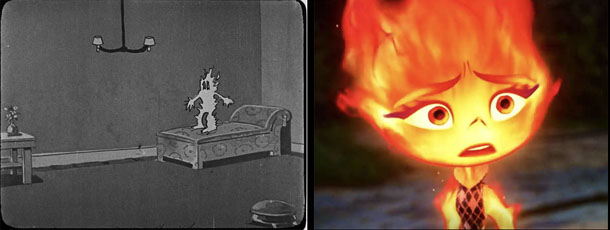
1926’s Mutt and Jeff in “Playing with Fire” (left) and Pixar’s “Elemental” (right)
This connection of drawing upon history is no stranger to Disney as they had been doing so since the start. In 1922, Walt Disney released Little Red Riding Hood through his Laugh-O-Gram Studios, the precursor to the modern Walt Disney Studios. Right from the start, Disney was pulling from the public domain, an ironic measure considering their support of copyright term extension. So it is fitting to finally see their totemic icon enter the public domain and become part of that history as well.
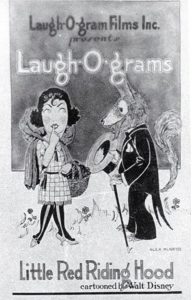 Mickey is a symbol for many things, for childhood, for extended copyright terms and the harm it can cause, but also for hope of what can and will be. It might be sad to think about all the time lost over 40 years of extension, but it is a wonderful thing to be in the present as well. As Steamboat Willie and Mickey join the public domain it will spark new creative expressions and critical evaluations of the character and the moment he inhabited. While these expressions might be limited at first, the adaptations are limited only to depictions of Mickey in Steamboat Willie and his other shorts from 1928, they will grow each year and more and more Mickey shorts enter the public domain. And with each short and new year it is an opportunity to be excited about what’s next.
Mickey is a symbol for many things, for childhood, for extended copyright terms and the harm it can cause, but also for hope of what can and will be. It might be sad to think about all the time lost over 40 years of extension, but it is a wonderful thing to be in the present as well. As Steamboat Willie and Mickey join the public domain it will spark new creative expressions and critical evaluations of the character and the moment he inhabited. While these expressions might be limited at first, the adaptations are limited only to depictions of Mickey in Steamboat Willie and his other shorts from 1928, they will grow each year and more and more Mickey shorts enter the public domain. And with each short and new year it is an opportunity to be excited about what’s next.
Over the next decade, works from the 1930s will begin to enter the public domain including iconic characters like Bugs Bunny and Daffy Duck. And while their iconic status has been cemented already, it will be interesting and informing to see lesser known or circulated works from the decade like Rainbow Parade, Ub Iwerks’ individual cartoons, and many works by Ted Esbaugh become public domain.
Each time a work enters the public domain, it has a new potential for a second life, for restored versions that we can all appreciate as animation fans, and for historians to have a better understanding of the moment when these were created and how they connect to our present. And while I for one am super excited to see what new half lives, appreciations, and discoveries and histories come about, right now I’m looking forward to watching Steamboat Willie on its Wikipedia page over and over and over. And maybe once more.
Steamboat Willie and the Importance of the Public Domain by Sean Dudley is marked with CC0 1.0
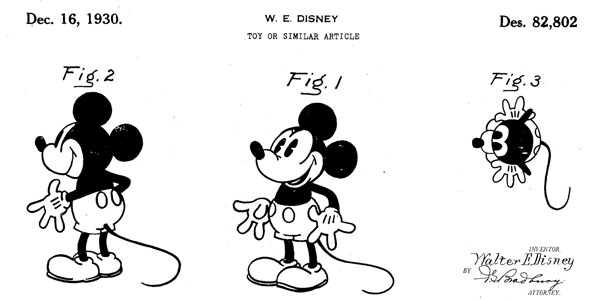
Trademarks cover words, logos, images, and other brand identifiers for the source of a product, to minimize consumer confusion when engaging with products. The US Supreme Court has said that trademarks should not be used to stymie what copyright expiration allows. This includes using public domain materials, including characters or stories, in new creative works. The Ninth Circuit Court of Appeals explained that when a work enters the public domain “[w]e all own it now” and trademark law “cannot be used to circumvent copyright law.”
However, trademarks can prevent the usage of public domain materials if they mislead consumers about the origin or sponsorship of a new product. This would apply to the unauthorized use of Mickey on merchandise similar to what Disney sells, but might also extend to a new creative work that uses Steamboat Willie in a way that suggests it is a Disney production. This might happen if Mickey appears as a logo at the beginning of a cartoon, for example. One way to ensure that the audience is not confused is to make the actual source of the work clear and to add a prominent disclaimer indicating that this work was not produced, endorsed, licensed, or approved by Disney.



